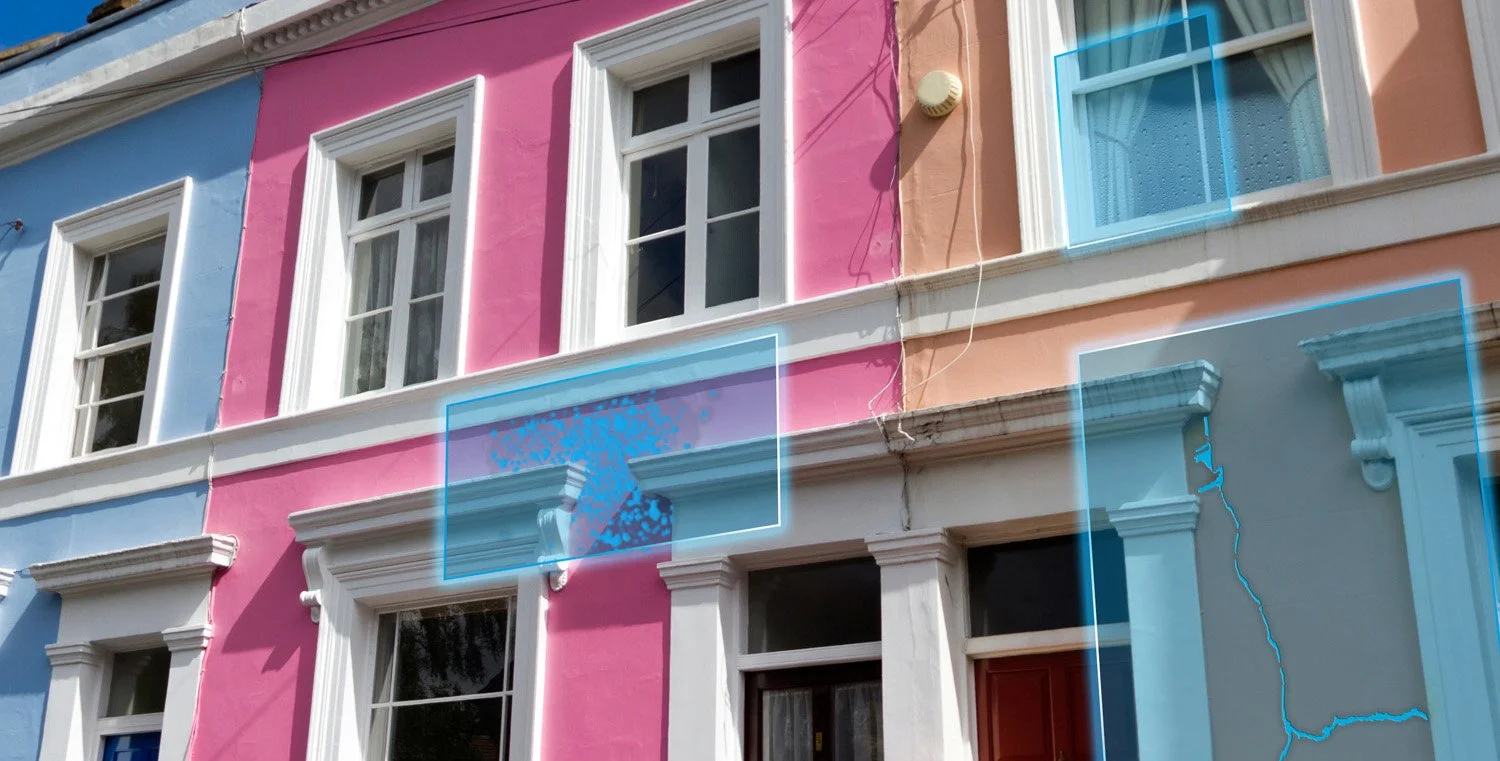Surveying Futures Series (Part 1): Computer Vision Defect Detection
The building surveying industry is undergoing a transformative shift, driven by the integration of advanced technologies such as computer vision for defect detection and building pathology. This is the first of a three-part series that explores how these innovations, along with AI assistants and real-time spatial technology, are revolutionising the field.
Computer vision uses image processing algorithms to detect and categorise defects in building structures. By analysing images captured through various means, such as drones, handheld devices, or fixed cameras, computer vision can identify cracks, moisture intrusion, and other anomalies that may not be visible to the naked eye. This capability allows for more accurate and comprehensive defect detection, enhancing the quality of building assessments.
One of the key benefits of computer vision is its ability to process and analyse large volumes of data quickly and accurately. Traditional methods of defect detection can be time-consuming and labour-intensive, often requiring manual inspection and documentation. Computer vision automates these processes, significantly reducing the time and effort required for defect detection. Additionally, computer vision provides consistent and objective assessments, minimising the risk of human error and subjective interpretation.
Computer vision also plays a crucial role in building pathology. By continuously monitoring buildings and analysing image data, computer vision can identify patterns and trends that indicate underlying issues. For example, recurring cracks or moisture stains may suggest structural instability or water leakage problems. Early detection of these issues allows for timely intervention and prevents further damage. Computer vision can also predict potential defects by analysing historical data and identifying risk factors, enabling proactive maintenance and reducing long-term costs.
Furthermore, the integration of computer vision with AI enhances the predictive capabilities of defect detection. AI algorithms can process large datasets and identify potential defects before they become critical issues. This integration allows for the development of predictive maintenance schedules, ensuring buildings remain in optimal condition and reducing unplanned downtime. AI-driven computer vision can also generate detailed reports and visualisations, aiding in clear communication with clients and stakeholders.
The use of drones equipped with high-resolution cameras and computer vision technology is revolutionising building surveys. Drones can access hard-to-reach areas, such as rooftops or tall structures, capturing detailed images that are analysed in real-time by computer vision algorithms. This capability not only enhances the thoroughness of inspections but also improves safety by reducing the need for surveyors to physically access potentially hazardous areas.
Research has shown that computer vision can significantly improve the accuracy and efficiency of defect detection. Studies indicate that computer vision algorithms can achieve high levels of accuracy in identifying various types of defects, including cracks, spalling, and moisture damage. For instance, a study published in "Automation in Construction" highlighted the effectiveness of convolutional neural networks (CNNs) in classifying and segmenting cracks on masonry surfaces. Another study demonstrated the potential of transfer learning to enhance the performance of computer vision models, enabling them to adapt to different types of defects and building materials.
Case studies further illustrate the practical benefits of computer vision in building surveying. For example, a project involving the use of computer vision for the inspection of historical buildings demonstrated its effectiveness in preserving architectural heritage. The technology was used to identify and document defects in the building's structure, providing valuable data for conservation efforts. Similarly, computer vision has been employed in the inspection of large infrastructure projects, such as bridges and tunnels, where traditional inspection methods are challenging and time-consuming.
The adoption of computer vision in building surveying represents a significant advancement in the field. By leveraging this technology, surveyors can enhance defect detection accuracy, improve building assessments, and ensure proactive maintenance. Surveyr, with its state-of-the-art computer vision technology, is at the forefront of this innovation, providing surveyors with powerful tools to enhance their inspections and deliver superior results. By integrating computer vision with its suite of advanced technologies, Surveyr ensures that building defects are identified and addressed promptly, safeguarding the integrity and longevity of structures.
As the field continues to evolve, the role of computer vision in building surveying is expected to expand further. Emerging technologies, such as augmented reality (AR) and virtual reality (VR), can complement computer vision by providing immersive visualisation of defects and their potential impact. These technologies can enhance the understanding of building conditions, enabling surveyors and stakeholders to make more informed decisions.
The future of building surveying lies in the seamless integration of advanced technologies, including computer vision, AI, real-time monitoring, and spatial analysis. By embracing these innovations, surveyors can elevate their practice, delivering higher quality assessments, improving safety, and ensuring the long-term sustainability of buildings. Surveyr is committed to leading this transformation, providing surveyors with the tools and expertise needed to navigate the challenges and opportunities of the digital age.
References:
Computer vision applications in construction: Current state, opportunities & challenges
"Building Pathology: Principles and Practice" by David Watt
A Perspective on AI-Based Image Analysis and Utilization Technologies in Building Engineering
Computer vision-based interior construction progress monitoring

